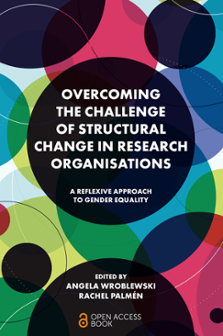
Index
ISBN: 978-1-80262-122-8, eISBN: 978-1-80262-119-8
Publication date: 25 July 2022
Citation
(2022), "Index", Wroblewski, A. and Palmén, R. (Ed.) Overcoming the Challenge of Structural Change in Research Organisations – A Reflexive Approach to Gender Equality, Emerald Publishing Limited, Leeds, pp. 213-218. https://doi.org/10.1108/978-1-80262-119-820221013
Publisher
:Emerald Publishing Limited
Copyright © 2022 Angela Wroblewski and Rachel Palmén
INDEX
Note: Page numbers followed by “n” indicate notes.
- Prelims
- Introduction
- Part I: Theoretical and Conceptual Framework
- Chapter 1: A Reflexive Approach to Structural Change
- Chapter 2: Relevance of Monitoring for a Reflexive Gender Equality Policy
- Chapter 3: Relevance of a CoP for a Reflexive Gender Equality Policy: A Structural Change Approach
- Part II: Substantive Issues of a Reflexive Gender Equality Policy
- Chapter 4: EU Policy and Gender Mainstreaming in Research and Higher Education: How Well Does it Travel from North to South?
- Chapter 5: Community of Practice for Gender Equality in the Network of Mediterranean Engineering Schools
- Chapter 6: Institutional Mechanisms for Combatting Sexual Harassment in Higher Education Institutions: The Case of the University of Belgrade
- Chapter 7: Promoting Gender Studies in Romania – Working in a Difficult Context
- Chapter 8: Incorporating the Gender Perspective in Engineering Curricula: The Case of École Centrale Marseille
- Part III: Experiences with Implementation of the Target Approach in RPOs and RFOs
- Chapter 9: Structural Change Towards Gender Equality: Learning from Bottom-up and Top-down Experiences of GEP Implementation in Universities
- Chapter 10: Promoting Structural Change in Small Organisations: Strengths, Resistance and the Quest for Excellence
- Conclusions
- Index